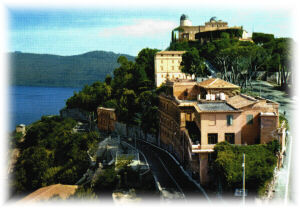| USEFUL
LINKS
CHANGE
ROME AIRPORTS
RAILWAYS
FORECAST
FORO ROMANO
COMUNE DI
FRASCATI
CASTELLI ROMANI (1)
CASTELLI ROMANI (2)
|
|
Frascati (m. 320.
22000 inhabitants) is really worth of attention due to its patrimony of
natural and artistic treasures. Its origin dates, back to the year 1191
after Tusculum (see below) was put to fire and sward. The Tusculum
survivors abandoned it and went to live below, at the hamlet then known
as frascata the bowery.
Frascati
is the best known of the so-called "Castelli Romani". In fact, when
people speak about Castelli they are often thinking of Frascati, and
this is even more true in regard of the wine, for its golden wine is
the best known of the Castelli vintages. Innumerable are the cantine
(wine-making companies or cellars) that make excellent and renowed
wines that are exported all over the world. The wine known as
"Frascati" is a "proven origin wine" (vino a denominazione di origine
controllata).
The
pastry of Frascati is equally well known: "pupazze" are honey cakes
shaped like men, women and animals. The women are always given three
breasts, probably a memory of some ancient fertility cult. Common
people say two breasts are for milk and one for wine. Also well known
are the wine cakes.
Yet
it is not only the wine that has given the town its fame, for there are
also its panorama reaching in the clear days from the Tyrrhenian sea to
the Sabine Hills, and patricians villas in marvellous parks. Sumptuous
villas were built on the slopes of Mount Tuscolo already in ancient
times: Lucullus and Cicero had villas here.
Villa
Torlonia, which is now a public domain, contains a splendid Water
Theatre built by Carlo Maderno. Unfortunately, nothing remains of the
old original building as the bomb of the 2nd world war razed it to the
ground.
Villa
Aldobrandini is the most illustrious example of Mannerist
architecture. It acts as a theatrical backdrop to the visitors of
Frascati. It was built at the end of the sixteenth century for Cardinal
Aldobrandini by Giacomo Della Porta, Carlo Maderno and Giovanni
Fontana. It contains magnificent rooms with paintings by the Zuccari
brothers, the cavalier d'Arpino and Domenichino. Its splendid grounds
are adorned with statues, grottoes, fountains and waterfalls.
Villa
Falconieri (on the road to Tuscolo), designed by Borromini, is the
most exquisite and refined example of Baroque art. It has rich frescoes
and a vast park.
Villa
Tuscolana (also on the road to Tuscolo) was built in the
seventeenth century by Vanvitelli.Thanks to its strategic position on
the Tusculum hillsides the Villa enjoy a breathtaking vista of Rome.
Villa
Mondragone (on the road to Monteporzio) was erected for the
Cardinal Altemps in 1572. It was begun by Longhi at the ned of the
sixteenth century and was continued by Vasanzio, rainaldi, and Ponzio.
It now belongs to the 2nd Rome University at Tor Vergata.
In
the centre of the town is the Cathedral Church of St. Peter,
with an eighteenth century facade by Girolamo Fontana. Henry Stewart,
Cardinal Duke of York, was bishop of Frascati and is buried in this
cathedral. The picturesque fountain in the square is also by G. Fontana.
The
Church of the Jesus is attributed to Pietro da Cortona.
A
drive of 5 km takes to the mount Tuscolo. On the hill (610 m) stood
ancient Tusculum. It is said to have been funded by Telegono, Ulysses's
son and the sorceress Circe. From the Roman period we can see an
amphitheatre, the remains of the forum, and a well preserved theatre,
the cistern, and an arch topped with a metal cross.
This summit gives a wide view of the
surrounding mountains, the Castelli, and the Roman countryside.
Frascati
houses the most important scientific centres in Italy that found here
calm and peace only a few minutes from Rome: the INFN, the ENEA (the
Italian Alternative Energy Authority) the CNR (Italy's National
Research Council) and the ESA (the European Space Agency).
|
|

Frascati, Villa
Aldobrandini

Frascati, Villa
Aldobrandini

Frascati, S. Rocco
church

Tusculum
History

Nemi, the lake

|
